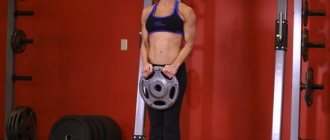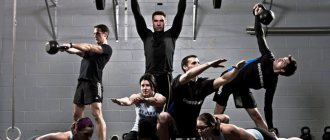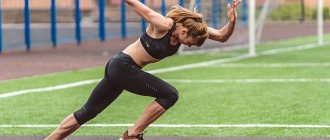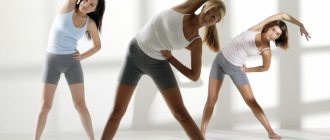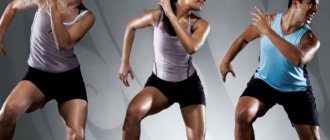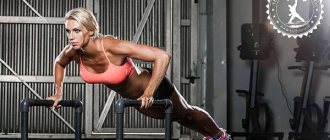Time under load
American strength training specialist Ian King was very closely involved in the study of the influence of the pace of exercise on changes in physical indicators (strength, explosive power, muscle volume, endurance). He outlined his conclusions in the book “Get Buffed,” which was published in 1999. Here are some of them:
- CONCLUSION #1: You need to use a different pace of exercise.
- CONCLUSION No. 2: it is not just the pace of exercise that is important, but the time that the muscle group is under load (TUT - time under tension or VPN - time under load).
As for this indicator, with VPN:
- 1-20 seconds – maximum strength and explosiveness develops
- 21-40 seconds – maximum strength and muscle hypertrophy develops
- 41-70 seconds – endurance and muscle hypertrophy develops
- CONCLUSION #3: Set durations exceeding 70 seconds are excessive; Sets of such duration can be resorted to only in extremely rare cases.
Here it is necessary to clarify that, for example, a set of squats in the “8 Weeks of Hell” program, lasting 120 seconds or more, is actually a set of sets, because during its execution you can stop more than once to rest; VPN is calculated based on the assumption that you do not pause at either the upper or lower points of the amplitude of movement.
Comprehensive muscle training
- Leg Raise
Technique for performing on a horizontal surface. Lift your upper body off the floor, lift your legs as high as possible or in a diagonal direction. Stretch your arms along your body and lift up and down 4 times, then twist 2 times. The contraction of the abdominal muscles should be controlled. Repeat 12 times.
- Spin-off from the support
Turn to face the supporting object, place your palm on it and take 1 step back. Place your palms slightly wider than your shoulders; the back is straight, the muscles of the buttocks are tense.
When performing push-ups, focus on your chest, try to touch it to the supporting surface, and then return to i. n. Repeat: 12 times.
Complication: do an incomplete press, perform 15 pushes up and down in this position, then return to the rep.
- Reverse spin
The goal is to work the triceps. Can be performed with or without a bench. I. p. sitting, knees bent, feet shoulder-width apart, hands behind the back, palms facing forward. Raise your hips up and shift your body weight to your hands.
Do reverse push-ups (bending and straightening your arms at the elbow joint) with your feet completely locked. We go down slowly, and up quickly. Repeat: 20 times. Next, the same actions, but on the heels.
A more difficult variation: standing on your heels, take 2-3 steps forward (body weight on your hands) and repeat again 15 times. Later, you can increase the number of repetitions from week to week. If there is pain, the number of repetitions is reduced.
- Leg exercise (variation 1)
Several muscle groups are involved. I.p. with your back to the support at a distance of approximately 12-15 cm. Feet at waist width, knees in a slightly bent position. Stretch your arms back and to the sides and grab a support.
Raise your straightened leg up, turn your foot to the right, as if “spreading” the leg muscles. In this and. p. perform for 30 seconds. the following types: lift up and lower your leg a few cm from the floor, make rotational movements with a small amplitude (as if you were drawing a circle with your heel).
Repeat the circular rotations, stretch your toes and raise and lower your leg 3-5 more times. Return to i. etc. and repeat with your right leg. Recommended training volume: 5-6 times, 3-4 approaches.
- Leg exercise (variation 2)
Accept and. item from the previous paragraph.
Raise the straightened limb up, turn the foot to the right, as if “opening” the muscles of the legs. Do 16-18 reps, then switch legs.
Actually about the tempo
Let us recall that the movement consists of a positive (concentric) phase, during which the weight is lifted, and a negative (eccentric), during which the weight is lowered (returned to its original position).
The end of the concentric phase is considered the top point of the amplitude of movement, the eccentric phase is considered the bottom (it’s a little strange to consider the bottom point in lat pull-downs to be the top point, but everything falls into place if you remember that lat pull-downs are “inverted” pull-ups).
Accordingly, when you come across numbers indicating the recommended pace of movement, the first of them will mean the duration of the negative phase, the second - the delay at the lower point of the amplitude of movement, the third - the duration of the positive phase, the last - the delay at the upper point of the amplitude.
Delay at the bottom point of the amplitude is typical for pressing movements, at the top - for traction, down presses or calf raises.
So, “4020” means that the weight is lowered in 4 counts, there is no delay at the bottom point, 2 counts are allocated for lifting, and there is no delay at the top point either. (! Please note: it is not seconds that are indicated here, but precisely the count. That is, pronounced measuredly “one, two” is a rise, “one, two, three, four” is a descent. Four counts are approximately 2.5 seconds. )
4020/4021 and 3020/3021 are precisely the main tempo for performing exercises in bodybuilding; most professional athletes adhere to it.
This is exactly the pace at which sets of 8-12 repetitions will last 30-40 seconds, that is, the work will be aimed at increasing strength and muscle hypertrophy.
If any phase of the movement TAKES 5 SECONDS (note - now seconds) or more, then such a repetition should be considered slow or super-slow. Slow repetitions are performed with strict technique. (What can often be observed in the gym, when the weight is lifted only with teeth, the body wriggles in wild convulsions, and the barbell (dumbbells) “walks” here and there, is not slow repetitions).
We’ll talk about slow and “explosive” repetitions a little lower, but for now everyone, especially beginners in training, should remember:
IF YOU CANNOT LIFT THE WEIGHT “ONE, TWO”, IT MEANS IT IS TOO BIGGER FOR YOU AND IT NEEDS TO BE LOWERED. OPTION: YOU SHOULD STOP THE APPROACH BECAUSE YOU ARE ALREADY TOO TIRED
At the same time, “pros” often use the 2010 pace. Almost always, for example, four-time “Mr. Olympia” Jay Cutler works at this pace. Why?
- Firstly, this pace makes it possible to take slightly more weight,
- secondly, at this pace it is often possible to perform more repetitions.
Very often this technique involves light cheating. As for the time under load, it is not much different from what you can achieve at 4020/4021 pace.
Fast and slow muscle fibers
In order to understand how our body works, it is necessary to explain to you that there are fast and slow muscle fibers. Our entire muscular frame consists of various muscle groups, including slow and fast fibers. They are called so because of their growth rate.
So, slow muscle fibers are very difficult to increase in size, some say almost impossible. These muscles cannot support very heavy weights, but they can withstand long and sustained stress. Such fibers are responsible for the dynamic work of muscles, keep our body in good shape throughout the day and produce the heat a person needs. These muscle fibers give our muscles endurance. If a person has a predominance of slow muscle fibers, then he rarely achieves great results in bodybuilding.
Fast muscle fibers , on the contrary, have great strength, but not as good endurance as slow ones. They get tired faster. The number of repetitions when working fast muscle fibers is much less, but the weight with which the exercise is performed can be limiting. That is, the maximum weight a person is capable of.
Each person is naturally endowed with an equal ratio of fast and slow muscle fibers. But it is not always the case. For some, fast muscle fibers predominate, while for others, slow muscle fibers predominate. You can determine your ratio using special equipment:
Determine your maximum weight for each muscle group, be it arms, chest, legs, etc. For this:
- Warm up your muscles before lifting extreme weights (lifting light weights on a given muscle group)
- Choose a weight that you can do 2 to 5 reps with.
- Rest 3 minutes.
- Take a weight that you can only do 1 rep with. Attention!!! Be sure to ask someone to cover you to avoid injury.
- Write down the maximum weight for each muscle group.
- Rest for 15 minutes.
- Use 80% of your maximum weight for each exercise.
- Perform as many reps as possible with this weight.
- Write down the result.
Test results:
- If you have completed up to 8 repetitions, then fast muscle fibers predominate (for this muscle group)
- If you have completed up to 10 repetitions, then the ratio of fast and slow muscle fibers is the same (for a given muscle group)
- If you performed up to 12 repetitions or more, then slow muscle fibers predominate (for this muscle group)
Explosive Replays
An “explosive” repetition refers to attempting to lift the weight as quickly as possible. Although the lowering is controlled (the weight is not just thrown down, but rather lowered), it also occurs at a fairly fast pace. To perform an exercise in an explosive style, the weight of the weight must be significantly reduced.
According to Ian King, explosive reps will only build maximal and explosive strength. Practice, however, shows that their implementation can be very useful for muscle hypertrophy.
By performing explosive reps, you will specifically target type IIb fibers that would otherwise be left largely unused. In addition, this style of performing repetitions involves the inclusion of more muscles in the work.
There is also a third reason, but it does not concern muscle hypertrophy: explosive training increases the body’s energy consumption, which means it is suitable for getting rid of excess subcutaneous fat.
We emphasize once again: THE WEIGHT OF THE WEIGHT SHOULD BE SIGNIFICANTLY REDUCED, USUALLY IT IS NO MORE THAN 50% OF YOUR ONE-TIME MAXIMUM. THE APPROACH SHOULD BE STOPED AS SOON AS THE SPEED OF REPETITIONS DECREASES AT LEAST A Slightly (USUALLY YOU CAN PERFORM 5-8 REPS IN AN “EXPLOSIVE” STYLE IN AN APPROACH)
Increasing the duration of the static repetition phase
Static load also has certain advantages.
For example, it helps increase the strength of ligaments and tendons. It should also be said that with a static load, little blood flows to the muscles, since the arteries are pinched. For this reason, muscle fibers are forced to work under conditions of severe hypoxia. It should also be remembered that thanks to static loads, the athlete is able to work with large weights, which is also an advantage of this technique.
Well, in conclusion, a few words about quickly performing movements. This allows you to increase the anabolism of fast fibers, which are much more susceptible to hypertrophy. For bodybuilders, it will be more effective to use balanced timing of the negative and positive phases. The emphasis on increasing the duration of the negative and positive phases should be done to achieve certain goals, such as increasing the strength of ligaments and tendons.
For more information about repetition tempo in powerlifting and bodybuilding, watch this video:
https://youtu.be/GEaiUKSQa48
Slow negatives
Slow “negatives” are useful when working towards muscle hypertrophy. As for strength indicators, slow “negatives” turn out to be effective for short-term increases and are virtually useless over a long period of time. That is, you should use slow negatives only in the immediate vicinity of the start, if we are talking about competitions in which the most important indicator is maximum strength.
An interesting point made by Ian King regarding the "negatives" is that he insists that the MAIN WORK DURING THE NEGATIVE PHASE OF THE MOVEMENT IS DONE IN THE LOWER THIRD OF THE AMPLITUDE. THAT IS, THERE IS NO SENSE IN STARTING THE MOVEMENT SLOWLY SO THAT AT SOME MOMENT JUST DROP THE WEIGHT. It’s better to quickly go through the upper half of the amplitude so that the main forces are spent on slow movement in the lower one.
CONCLUSION
“Low-intensity resistance training with slow movements is effective in increasing muscle size and strength, even in older individuals,” the researchers concluded.
"Because low-intensity resistance training with slow movements carries a lower risk of orthopedic injury and cardiac events, this could be a countermeasure against sarcopenia."
For more information about a study conducted at the University of Tokyo on the effects of mindfully slow repetitions, click here.
Source: J Aging Phys. Act. 2013 Jan;21(1):71-84.
Exercises
It is advisable to supplement the training methodology when preparing for middle-distance running with other exercises.
Below are the most popular and useful exercises for runners.
Jumping
Jumping is like running in place! If you don’t have a jump rope, you can jump without it. In fact, every athlete has the opportunity to choose exercises that are interesting to him, the main thing is that they are based on jumps. Someone jumps for five minutes, someone tries to jump as high as possible, someone jumps over obstacles - all this is very useful.
Power
A runner doesn't need too much muscle mass, so strength exercises need to be chosen carefully. Running in place near a wall with high knees, planking, swinging legs from a lunge, jumping from a half-squat, jumping from foot to foot are suitable. You can do push-ups and do static exercises, for example, temporarily raising your legs or arms with dumbbells.
For flexibility
Stand up, bring your legs together.
Lean forward with a spring, trying to touch your fingers to the floor. Having reached the maximum position, stay in it for 15-30 seconds . In the future, try to touch the floor with your palms.
Sit on the floor, bend one leg and straighten the other back. Keep your torso straight, fix your hands on the floor. Move your torso back and forth with a spring and slide your foot back so that the outstretched leg stretches. Change your leg.
Different kinds
Running is considered an excellent exercise in itself, but each variety trains the body differently. When preparing for middle-distance running, you cannot do without jogging, cross-country running, and interval running.
- Calm running. From time to time, you should definitely include a calm run in your workout, which does not require significant stress from you.
Such races should be performed in a stadium, on a smooth, asphalt surface without descents or ascents (or on a treadmill). Depending on the degree of physical fitness of the athlete, the speed of a quiet run can range from 4 to 8 kilometers per hour. This pace allows you to really run a lot and test your abilities. It is monotonous, without acceleration or intervals. - Interval running. What happens if you combine calm running with acceleration?
Get an excellent exercise called interval running. For thirty seconds we run as slowly as we feel comfortable, and then for ten or twenty seconds we accelerate to the limit. Then, without stopping, we again switch to a calm run and rest for thirty seconds, and again switch to a fast pace. This type of running is aimed at training endurance and is an excellent exercise for those who want to lose weight. - Cross. Any self-respecting runner should get outside the stadium and run a cross-country race from time to time.
Since natural terrain is rarely as flat as a stadium track, it makes for great exercise with uphills, natural obstacles, and downhills to rest on. Cross-country is considered a universal workout, which is chosen by athletes of completely different disciplines to prepare for competitions.
Keep an eye on your heart rate!
Pulse is the main indicator of the body’s condition , so we recommend that all athletes monitor its value.
A heart rate monitor that you wear on your arm will be a good helper in this matter. But even without it, you can measure your heart rate by placing your finger on your wrist.
To understand how intense the workout was, it is enough to measure your heart rate immediately after completing the main part of the workout. As a rule, after finishing the cool-down, the pulse should return to normal and not exceed 100 beats.
For a quiet easy run, 120-130 beats per minute are typical, a threshold of 140 beats per minute is already considered a cardio load, for cross-country 170-180 beats per minute, this pulse will also be during acceleration during interval running.
However, note that your heart rate should decrease as you settle into a gentle run.
Speed of performing exercises to increase mass
To increase muscle mass, perform exercises at a slow pace. Delay the process of lowering loads. It is this stage of training that promotes muscle mass gain. The secret is that the longer you lower the weight, the more cracks will appear in the muscle fibers. They promote the appearance of new tissues in the body. Secondary pauses allow the connective tissues to relax, this, in turn, disrupts the “stretching” stage, and thus the entire load is transferred to the muscle tissues.
